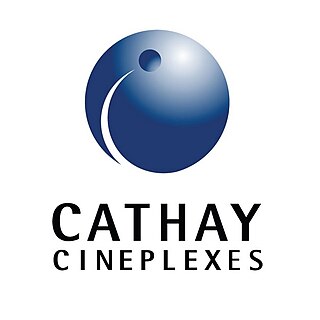
A movie theater or cinema, also known as a movie house, cinema hall, picture house, picture theater, the pictures, or simply theater, is a business that contains auditoriums for viewing films for public entertainment. Most are commercial operations catering to the general public, who attend by purchasing tickets.

A drive-in theater/theatre or drive-in cinema is a form of cinema structure consisting of a large outdoor movie screen, a projection booth, a concession stand, and a large parking area for automobiles. Within this enclosed area, customers can view movies from the privacy and comfort of their cars. Some drive-ins have small playgrounds for children and a few picnic tables or benches.

Jurong East MRT station is an elevated Mass Rapid Transit (MRT) interchange station on the North–South (NSL) and East–West (EWL) lines in Jurong East, Singapore. Situated along Jurong Gateway Road, the station is located within the vicinity of Jem, Westgate, IMM, Ng Teng Fong General Hospital, Jurong East Bus Interchange and Jurong Town Hall Bus Interchange. The station is operated by SMRT Trains.

Tan Sri Loke Wan Tho was a Malaysian-Singaporean business magnate, ornithologist, and photographer. He was the founder of Cathay Organisation in Singapore and Malaysia, and Motion Picture and General Investments Limited(MP&GI) in Hong Kong.
The following lists events that happened during 1971 in Singapore.

Science Centre Singapore, previously known as the Singapore Science Centre, is a scientific museum in Jurong East, Singapore, specialising in the promotion of scientific and technological education for the general public. It houses over 850 exhibits over eight exhibition galleries and receives over a million visitors every year. In 2003, it celebrated its silver jubilee.

The cinema of Malaysia consists of feature films produced in Malaysia, shot in the languages Malay, Mandarin, Cantonese, Tamil, various indigenous languages, and English.

Shaw Organisation is a film distribution company and cinema chain founded by brothers Runme Shaw and Run Run Shaw who went to Singapore in the 1920s to expand their family business founded by Runje Shaw. The company originally operated as a distributor for the Shaw brothers' Tianyi Film Company in Shanghai. Run Run Shaw later moved to Hong Kong in the 1950s to run Shaw Brothers Studio, whilst Runme Shaw stayed in Singapore to continue Shaw Organisation's operations. Unlike Tianyi, Shaw Organisation does not produce films but distribute them in their theatre's.

The Cathay Building was opened in 1939 by Dato Loke Wan Tho as the headquarters for the British Malaya Broadcasting Corporation. Located at 2 Handy Road in the Museum Planning Area of Singapore, the building was most known for its air-conditioned theatre known as the Cathay Cinema, then a technological marvel and the first to be built in Singapore. Cathay Building was the first skyscraper in Singapore and tallest building in Southeast Asia at that time. It was demolished in 2003.

Village Cinemas is an Australian-based multinational film exhibition brand that mainly shows blockbusters, mainstream, children and family films and some arthouse, foreign language and documentary films.

The Majestic is a historic building on Eu Tong Sen Street in Chinatown, Singapore next to Chinatown MRT station. Located between the People's Park Complex and Yue Hwa Building, it was known as Majestic Theatre, which was a Cantonese opera house.
Eng Wah Global, formerly Eng Wah Organisation and Eng Wah Theatres Organisation, is a Singaporean company spans entertainment, properties, hospitality, and lifestyle in Singapore and Malaysia.

The Rio Cinema is a Grade II listed independent Art Deco cinema in Dalston, east London. It is a popular independent cinema located on Kingsland High Street, with a history stretching back over 100 years. The Rio added a second screen in the unused basement space in December 2017.

Tomorrow Theater is a movie theater and multimedia space in Portland, Oregon, United States. It is operated by PAM CUT // Center for an Untold Tomorrow, the film and new media center of the Portland Art Museum.

600 @ Toa Payoh, formerly Central Cinema (中央戏院) and Kong Chian Cinema (光前戏院), is a commercial building and a former cinema in Toa Payoh town centre which was located near the Toa Payoh Public Library. The building currently houses a pool centre, amenities, eateries and a 24 hours McDonald's fast food restaurant.

Cathay Cineplexes is a cinema chain established in 1939 in Singapore. The Cineplexes started as Cathay Cinema as Singapore's first air-conditioned cinema and first to screen American and British films in Singapore. The company is owned and operated by Singapore-listed media conglomerate mm2 Entertainment.

Coburg Drive-In is a heritage-listed drive-in theatre operated by Village Cinemas in the Melbourne suburb of Coburg. Films are screened throughout the week, and the site is also used for the Coburg Trash and Treasure Market on Sundays during the day.

Fairfield Methodist Church, formerly the Metropole Theatre or the Jing Hwa Cinema, is a building at the junction of Tanjong Pagar Road and Maxwell Road in Chinatown, Singapore. Formerly one of the "three famous cinemas" of Chinatown, it presently serves as a Methodist church.
















